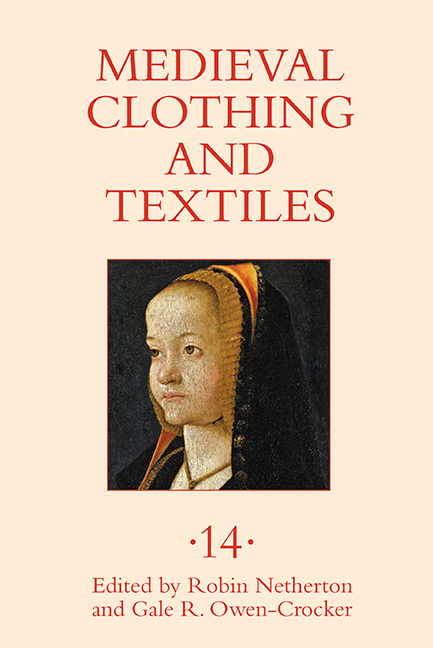Book contents
- Frontmatter
- Contents
- Illustrations page
- Tables
- Contributors
- Preface
- 1 Multicultural Clothing in Sixth-Century Ravenna
- 2 Byzantine and Oriental Silks in Denmark, 800–1200
- 3 The Bliaut: An Examination of the Evidence in French Literary Sources
- 4 Eyebrows, Hairlines, and “Hairs Less in Sight”: Female Depilation in Late Medieval Europe
- 5 Lexical Exchange with Italian in the Textile and Wool Trades in the Thirteenth to Fifteenth Centuries
- 6 Hidden in Plain Black: The Secrets of the French Hood
- Recent Books of Interest
- Contents of Previous Volumes
2 - Byzantine and Oriental Silks in Denmark, 800–1200
Published online by Cambridge University Press: 13 July 2019
- Frontmatter
- Contents
- Illustrations page
- Tables
- Contributors
- Preface
- 1 Multicultural Clothing in Sixth-Century Ravenna
- 2 Byzantine and Oriental Silks in Denmark, 800–1200
- 3 The Bliaut: An Examination of the Evidence in French Literary Sources
- 4 Eyebrows, Hairlines, and “Hairs Less in Sight”: Female Depilation in Late Medieval Europe
- 5 Lexical Exchange with Italian in the Textile and Wool Trades in the Thirteenth to Fifteenth Centuries
- 6 Hidden in Plain Black: The Secrets of the French Hood
- Recent Books of Interest
- Contents of Previous Volumes
Summary
The earliest silk in Denmark appears about AD 800. From the first, it evidently had great importance as a status symbol, marking the elite in both the secular aristocracy and the Church. This article brings together Danish silks up to 1200 for the first time, demonstrating their social importance. The study focuses in large part on the unique royal burial find of the Eagle Silk from Odense and other silks from graves and reliquaries, among them that of Bishop Absalon (d. 1201). The royal shrine belongs to the most important medieval monument of Denmark, and international research regards the finds from Odense to be highlights even in a European context, mostly attributing them to Byzantium. Therefore the Odense silks, along with new analyses of the silks from Sigersted Church, are central to this study. The study includes previously unpublished scientific evidence about the colours. The article also suggests probable ways in which silk reached Denmark in the period 800–1200.
Most of the silks in Denmark dating from 800 to 1200 were made in the Mediterranean region and woven as samite. (A full list of the surviving silks appears in table 2.1.) Samite weaving had been developed by the Persians of the Sassanid period (226–661). This technique exploited the qualities of the silk in the best possible way. Unlike the Chinese, who wove with a technique where the long vertical threads (the warp) predominated, the Sassanid Persians developed a technique where the weft threads predominated, covering most of the weave without interruption. If the weft thread was unspun—that is, made of reeled silk—the lustre of the silk was particularly evident. The cloth was just as smooth on the back, where the pattern appeared in the opposite colours. Silk produced in the Mediterranean in the sixth and seventh centuries was often woven in small patterns, sometimes with small birds, animals, and Christian figures. The samite weaving technique was later taken up by Byzantine silk weavers. The exclusive imperial silk, which had its origins in Byzantine and Sassanid culture, was woven in special workshops, the so-called gynaecea. Byzantine silk production was still active from 800 to 1200. Byzantine silks are known from many European churches, where they were often associated with relics. The motifs were often Oriental and inspired by Sassanid silks.
- Type
- Chapter
- Information
- Medieval Clothing and TextilesVolume 14, pp. 37 - 60Publisher: Boydell & BrewerPrint publication year: 2018
- 1
- Cited by



